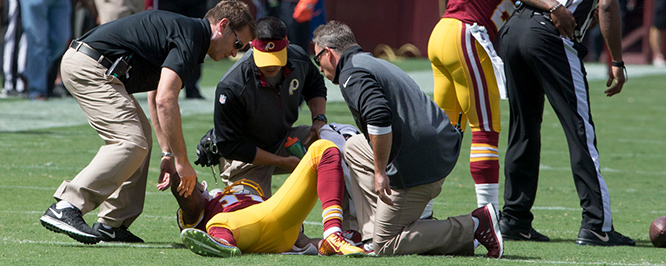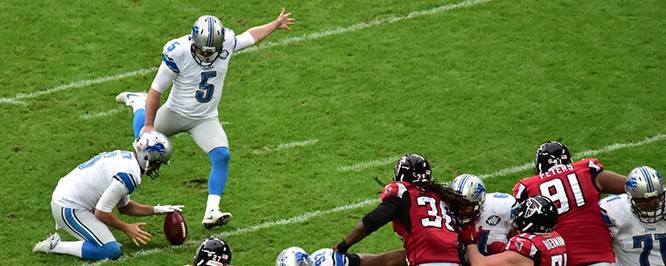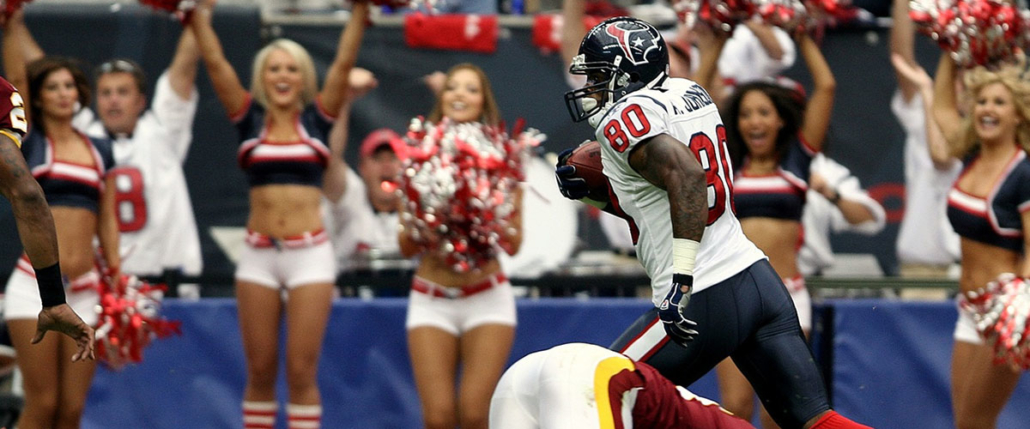NFL DFS Beginner’s Guide
Stacking Receiver(s) with QB
With the right matchup, playing a quarterback and receiver(s) on the same team can pay off big time. While it sometimes is a feast or famine approach, it can help you cash in big bucks. Stacking a QB with his best WR is not a bad decision in a cash game; however, stacking in a cash game is less encouraged. In a GPP tournament, a stacking option could involve your QB with aWR(s) on his team that might have low ownership. A strategy that can also be employed is stacking your TE with your QB. This is a sneaky smart play that allows you to reap the benefits of a QB that likes to use his TE down in the red-zone. Stacking is more likely to take place in a GPP setting and is a risk-reward scenario. Look for strategic places to stack such as a powerful passing offense match-up against a porous pass defense.
Vegas odds
If you gamble on sports at all, you know how spot on those oddsmakers are, especially when it comes to the NFL. Knowing that makes ita bit easier to see which games are likely to have more points score. Vegas provides point total over/unders for both teams combined and for each team individually. More points on the scoreboard means more DFS points. Use this to your advantage when filling out your lineup each week. Using the Vegas over/under combined with the point spread is useful in determining which position to roster. If the over/under is high and the point spread is small, this might be a good spot to play a QB as Vegas sees it as a potential back-and-forth high scoring affair. If the over/under is high and the point spread is big, this might be a good spot to play a RB on the favored team. A team with a big lead is more likely to use the run game to kill clock with a lead in the 4th.
Injuries Including Last Second Announcements
 There are a couple of strategies when it comes to gametime injury decisions. You can stay away from any players who might fall in that category. Or you can choose to play those players and monitor the situation accordingly. If you elect to play those gametime guys, please make sure you have a backup option. The last thing that you want is for Marshawn Lynch to be a last minute scratch before a 3pm kick and you have no backup plan in place. Even if an injured guy suits up and plays, there is the risk of re-injury or limited playing time so consider that before rostering an injured player, too. If you’re willing to take a risk on an injured player, it could result in you getting a player with low ownership numbers and is a nice contrarian play in a GPP format.
There are a couple of strategies when it comes to gametime injury decisions. You can stay away from any players who might fall in that category. Or you can choose to play those players and monitor the situation accordingly. If you elect to play those gametime guys, please make sure you have a backup option. The last thing that you want is for Marshawn Lynch to be a last minute scratch before a 3pm kick and you have no backup plan in place. Even if an injured guy suits up and plays, there is the risk of re-injury or limited playing time so consider that before rostering an injured player, too. If you’re willing to take a risk on an injured player, it could result in you getting a player with low ownership numbers and is a nice contrarian play in a GPP format.
WR over RB Generally Better in GPP for Flex
The NFL has shifted from a ground game to a high-flying passing game. With that knowledge, I think it wise to use a WR in the flex position rather than a RB. Not that you can’t fill the flex position with a runner but a low priced #3 receiver is a better play than a low-priced RB who splits carries. In PPR formats, you’d be a fool to play a RB in the flex over a WR or TE so familiarize yourself with the scoring of the site you’re playing on. PPR formats offer a point for every reception which exponentially increases the value of the WR in the flex. Also, WR typically cost less to roster than a RB, especially the lower-tier options. An alternative is to take the RB in the flex position due to the likelihood of them getting more touches than a WR. More touches does not mean more productivity though so be careful in thinking touches equals more points.
Projections
A key stat to understand is the projected touches for skill position players on a weekly basis. Depending on the style of offense they run or what defense they are playing against, the number of touches can vary. Obviously, the QB will have the ball in his hand on every play, making the QB position critical in your DFS contests, whether cash game or GPP. Number of targets for a WR is the best measure of how many times it’s likely that WR will touch the ball. As for the RB position, a simple number of carries and/or catches projection lets you know the projected number of times they will touch it. The more touches, the more opportunities to put up points.
Expert Help
The key here is finding someone that you trust and sticking with that person. DailyOverlay is the perfect place to find that expert to trust as we are THE source for expert grading. We grade the “experts” so that you know who to trust on a week-to-week basis. All this being said, it always pays to trust your gut. Relying on an “expert” to fill out your roster each week is boring and not very fun.
Values (cheap starters)
Finding “value” plays are a key each week. A place to start is at the WR position. There are always a couple of cheap options that can provide a nice return on investment. Finding a QB with a favorite deep threat in the passing game can pull in a lot of DFS points at a reasonable investment. Of course, this is a boom or bust strategy but is worth the risk. If you want to win a GPP format, you are going to have to take some risks on boom-or-bust value plays. Also, pay attention to particular players that might be expected to have a heavier workload in a particular week. If the DFS site you play on has not priced them up yet then this is a good opportunitity to grab values.
Defense vs. Pass/Run for Choosing QB/WR/RB
An important factor to consider when filling out your skill position DFS players is the opposing defense. You wouldn’t have played a RB against those Bears defenses from 6-8 years ago. As for nowadays, it’s never a bad decision to stay away from a WR that is matched up against a lockdown corner such as Richard Sherman. By paying close attention to defensive numbers against the pass/run, you can give yourself an edge when selecting which skill players to roster.
Don’t Waste Money on the Kicker
 When it comes to kickers, take the same approach as you would in a season long fantasy league. Personally, I think it is wise to wait until the very last round of a fantasy draft to pick a kicker. Translating that to DFS means…Don’t waste money on your kicker. However…the school of thought may be changing on this as DFS advances. Check out our articles starting this year about Kicker selection and maybe you should spend a little bit more on a good kicker.
When it comes to kickers, take the same approach as you would in a season long fantasy league. Personally, I think it is wise to wait until the very last round of a fantasy draft to pick a kicker. Translating that to DFS means…Don’t waste money on your kicker. However…the school of thought may be changing on this as DFS advances. Check out our articles starting this year about Kicker selection and maybe you should spend a little bit more on a good kicker.
Selecting a Defense
The best strategies here are to find a defense that is facing a low-scoring offense or one that forces a lot of turnovers. A play that seems to work well early in the season is playing a defense against a rookie QB. The team with the young QB tends to play a very vanilla offense in order to hide any potential deficiencies with their youngster and tends to lend itself to a lower scoring output. Also, use the Vegas odds to help you when selecting a defense that is facing an offense that is going to score less.
Weather
 Be sure to check the weather before drafting your lineup. Where the weather is poor, there will likely be less points scored. Wind and rain will have a big effect on the passing game, therefore, the QB, WR and TE positions decrease in value. On the flip side of that, a windy/rainy weather outlook creates a perfect opportunity to draft a RB that will see an increase in carries.
Be sure to check the weather before drafting your lineup. Where the weather is poor, there will likely be less points scored. Wind and rain will have a big effect on the passing game, therefore, the QB, WR and TE positions decrease in value. On the flip side of that, a windy/rainy weather outlook creates a perfect opportunity to draft a RB that will see an increase in carries.
Know Your Site
The different DFS sites offer varying point scales. Some may offer added points for 100-yard rushers or 300-yard passers. Make sure you know this as you might be more likely to pay up for a Drew Brees or Aaron Rodgers when you get added points for that 300-yard passing mark. If there are no extra incentives, you might be more likely to save some cash at QB by playing someone else and use the cash saved for your other positions. Now try it out:

